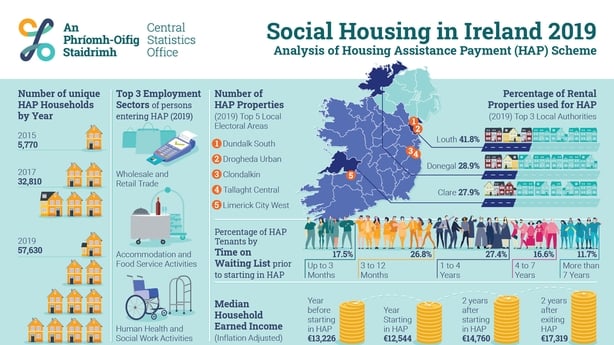The Central Statistics Office has carried out an analysis of the Housing Assistance Payment (HAP) scheme, where landlords enter into long term agreements with Local Authorities to house tenants.
The scheme accounted for 57,630 households in 2019, the CSO figures show.
The number of new HAP tenancies peaked at 16,930 in 2017 and slowed to 14,540 in 2019.
In 2018, 53.9% of HAP households had some PAYE employment. That percentage was 62% in the four Dublin local authorities.
The median household annual income nationally was €13,816. 20% of households earned less than €5,000 a year. The highest median income was in Meath (€18,606) and the lowest was in Mayo (€7,842).
In 2019, just over one in five (20.5%) of HAP tenants worked in the Wholesale and Retail sector compared to an average 13.4% across the national workforce.
16.6% worked in Accommodation & Food compared to a national average of 7.9% and the percentage working in Human Health and Social Work rose from 11.4% to 15.2%.
The earned incomes of HAP tenants rises by an average 18% in the two years after securing a tenancy.
44% of those on HAP spent a year or less on a Local Authority waiting list. However, 21.4% spent five years or more.
The biggest family groups entering HAP in 2019 were single parents with one child and single people, with both groups each representing just under 23% of the total.

Referrals from homeless services rose from 3.1% of applicants in 2014 to 21.1% in 2019.
The county with the highest percentage of registered rental properties under HAP tenancies was Louth at 41.8%.
Over 85% of HAP landlords nationally had just one property, today's CSO figures also show.






